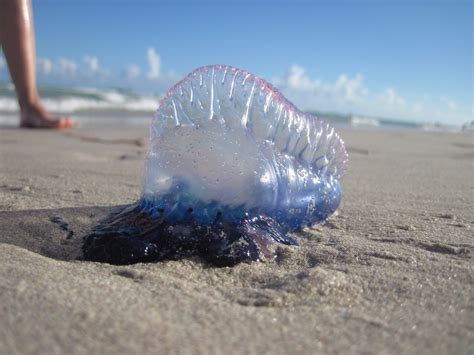If you’ve ever gone swimming in the ocean, then you probably know that jellyfish can be a nasty surprise. Fortunately, jellyfish don’t typically inhabit the waters of Miami Beach, so you can be sure that your time in the water won’t be disrupted by these squishy creatures.
The warm waters of Miami Beach may appear inviting for jellyfish, but the area’s strong currents and waves make it an unlikely home for these creatures. Additionally, a wide variety of other sea life (including many species of fish) inhabit the waters of Miami Beach, which is another factor that works against jellyfish making the area their home.
In the rare event that there are jellyfish in Miami Beach, they will usually be found near the shoreline. The most common type of jellyfish that you might find in the waters of Miami Beach is the Portuguese man-of-war, which can cause a painful sting if it brushes against your skin.
If you do see jellyfish in the waters of Miami Beach, there are a few safety tips that you should follow to protect yourself:
- Stay away from areas where jellyfish might be present
- Avoid swimming in areas with murky water, as this is where jellyfish tend to congregate
- Wear protective clothing, such as a wetsuit or a rash guard, when swimming in areas where jellyfish might be present
- If you get stung, seek medical attention immediately
If you’re ever unsure about whether there are jellyfish in the waters of Miami Beach, you can always ask a lifeguard for advice. They’ll be able to tell you whether it’s safe to go for a swim.
In general, though, jellyfish don’t typically inhabit the waters of Miami Beach, so you can be sure that your time in the ocean won’t be disrupted by these creatures.
Exploring The Jellyfish Population In Miami Beach
Miami Beach is a coastal city in Miami-Dade County, Florida. With its beautiful beachfront, Miami Beach is one of the most popular tourist destinations in the world. But did you know that Miami Beach is also home to a thriving jellyfish population?
Jellyfish have been present in the waters off Miami Beach for many years. In fact, the city’s first jellyfish sighting was reported in 1881. Since then, the jellyfish population in Miami Beach has grown steadily. Today, the waters off Miami Beach are home to a variety of jellyfish species, including moon jellyfish, blue blubber jellyfish, and spotted jellyfish.
Exploring Miami Beach’s jellyfish population can be a great experience. There are numerous boat and kayak tours that offer guided tours of the jellyfish habitats. These tours are typically two to three hours in length, and they provide a close-up look at the jellyfish and their habitats. Most tours also provide visitors with educational information about the jellyfish.
Tours typically cost between $25 and $50 per person. Some companies also offer special discounts for large groups. In addition, some tour companies offer snorkeling and diving excursions, which allow visitors to get a closer look at the jellyfish.
If you’re interested in exploring the jellyfish population in Miami Beach, there are a few things you should keep in mind. First, jellyfish are delicate creatures and must be treated with care. Also, it’s important to check the weather conditions before heading out on a jellyfish tour. Heavy winds and choppy waters can make jellyfish viewing difficult. Finally, be sure to wear a dive suit to protect yourself from jellyfish stings.
In conclusion, Miami Beach is home to a thriving jellyfish population. Exploring the jellyfish habitats can be a great way to learn about these fascinating creatures. With its beautiful beaches and temperate climate, Miami Beach is the perfect place to explore these unique creatures.
The Risk Of Jellyfish Stings In Miami Beach
Are there Jellyfish in Miami Beach? The short answer to this question is yes. Although the risk is low, jellyfish stings are a potential hazard when swimming in the waters off Miami Beach.
Jellyfish are commonly found in the waters off Miami Beach, especially during the summer months. Although these jellyfish are typically harmless, there are a few species capable of delivering a painful sting. Those that sting are typically the Atlantic sea nettle, the man-of-war, and the brown sea nettle. It’s important to note that these jellyfish can still be found in the waters even if they’re not in season, so it’s important to swim with caution.
It’s also important to note that jellyfish stings can be quite painful. Symptoms can include burning, itching, and redness at the affected area, as well as pain and swelling. In some cases, stings can also cause headaches, nausea, and dizziness. In rare cases, jellyfish stings can also cause an allergic reaction or even anaphylaxis. If you experience any of these symptoms after being stung, it’s important to seek medical attention.
Fortunately, there are a few tips you can follow to help reduce your risk of being stung. One of the most important tips is to avoid swimming in areas with large concentrations of jellyfish. It’s also important to wear protective clothing such as wetsuits or rash guards. Additionally, it’s a good idea to be aware of any jellyfish warnings that may be issued by local authorities.
To ensure your safety, it’s also important to know how to treat a jellyfish sting. If you are stung, it’s important to immediately leave the water and rinse the affected area with saltwater. You can then apply a cold compress or a paste made of baking soda and vinegar to help reduce the pain and swelling. It’s also important to seek medical attention if you experience any of the symptoms mentioned earlier.
| Type of Jellyfish | Risk of Sting |
|---|---|
| Atlantic Sea Nettle | Moderate |
| Man-of-War | High |
| Brown Sea Nettle | Moderate |
While jellyfish stings can be quite painful, the risk of being stung is relatively low. By following the tips mentioned earlier, you can greatly reduce your risk of being stung. It’s also important to understand the proper treatment for a jellyfish sting should you ever find yourself in that situation.
 Road Topic Tourism & Travel
Road Topic Tourism & Travel




